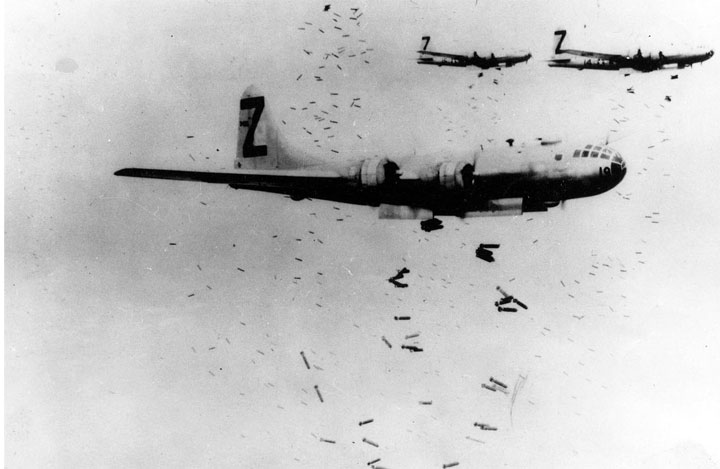NOVEMBER 29th 1944 First B-29 Raids On Japan

General MacArthur landing
On November 29th, 1944 the United States began bombing or Japan from the Mariana Islands using B-29 bombers. The B-29 called Superfortress. The Japanese did not have fighter aircraft that could engage the B-29’s and thus they were unable to defend against the attacks. The raids began slow but rapidly grew in size and by the end of the war had destroyed a large percent of the Japanese industrial capabilities.Bombing of Germany had begun at the beginning of the war, however bombing Japan was a much more difficult challenge due to the distances involved. The first US bombing of Japan took place with the Doolittle mission where medium bombers were launched from an aircraft carriers. The Doolittle mission in 1942 was launched for psychological reasons and was never expected to have any significant strategic impact. The attempt to start bombing the Japanese home islands came with Operation Matterhorn. The concept to fly B-29 bombers from bases in India, refuel them in China and then bomb Japan from there. The base to refuel the planes was but in Chengdu, which meant that only southern Japan was in range. 12 raids were carried on as part of the operation, but the long distances involved combined with the difficulty getting aviation fuel to both India and China greatly limited the effectiveness of the raids. Operation Matterhorn was considered a failure.
The American forces captured the Marianas Islands between June and August 1944 and construction crews immediately began building six airfields to accommodate B-29 bombers. The airfields were only 1,500 miles south of Tokyo well within the range of the B-29. After making a number of practice runs against targets in the Pacific, the first raid against Japan codenamed Operation San Antonio I was launched on November 24, 1944. 111 B-29 were launched at the Musashino aircraft factory on the outskirts of Tokyo. 24 of the planes hit their target with the rest attacking surrounding locations. Only one plane was lost. The American planes flews too fast and too high for the Japanese to put up a significant defense. The air force continued a campaign of precision raids against aircraft and other high value targets. High winds and bad weather over the targets limited the effectiveness of many of the raids. The Air force lost between 4-5% of the aircraft on most raids due to anti aircraft fire and mechanical problems.
After having only limited success the air force decided to change tactics and begin firebombing Japanese cities. The first attack took place on March 10th. 279 bombers dropped 1,665 tons of incendiary bombs on Tokyo. The resulting fire destroyed 16 sq miles of the city representing 8% of its urban area. 83,000 people were killed another 40,000 were injured. Over 1 million people lost their homes and war production was clearly hurt. After the success of the first raid it was decided to continue the nighttime fire raids on Japanese cities. The raids continued and all the large cities were attacked and mostly destroyed and Japanese war production was crippled. While the total number of Japanese killed in the raids is not known, estimates range from 250,000 to 900,000. A total of 160,800 tons of bombs were dropped on Japan in the less than one year of bombing. A total of 2,600 bomber crew member died either when their planes crashed or in captivity.
 >
>